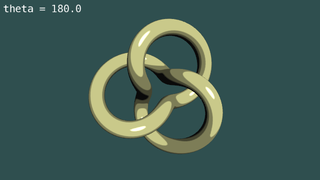Strings Inside Vertex Buffers
Pass a C string into your draw call
This has got to be the stupidest OpenGL trick ever. Imagine passing a C-style string directly into a POINTS draw call. No quads, no vertex positions, no texture coordinates; just raw ASCII. For example:
const char* text = "Hello world.";
glVertexAttribIPointer(CharAttrib, 1, GL_UNSIGNED_BYTE, 1, text);
glDrawArrays(GL_POINTS, 0, strlen(text));This is legal. It’s important to use the IPointer suffix for glVertexAttrib, otherwise GL will try to normalize your values instead of passing them straight through.
I did something similar to render text on my Toon shading demo:

The vertex shader simply passes gl_VertexID and the character to the geometry shader:
-- Vertex Shader
in int Character;
out int vCharacter;
out int vPosition;
void main()
{
vCharacter = Character;
vPosition = gl_VertexID;
gl_Position = vec4(0, 0, 0, 1);
}Most of the logic lives in the geometry shader; it expands the points into quads and computes the correct texture coordinates. It assumes you’re using a monospace font arranged into an atlas with 16 rows and 16 columns. The first character in the atlas is a space character (ASCII code 32).
-- Geometry Shader
layout(points) in;
layout(triangle_strip, max_vertices = 4) out;
in int vCharacter[1];
in int vPosition[1];
out vec2 gTexCoord;
uniform sampler2D Sampler;
uniform vec2 CellSize;
uniform vec2 RenderSize;
uniform vec2 RenderOrigin;
void main()
{
// Determine the final quad's position and size:
float x = RenderOrigin.x + float(vPosition[0]) * RenderSize.x;
float y = RenderOrigin.y;
vec4 P = vec4(x, y, 0, 1);
vec4 U = vec4(0.5, 0, 0, 0) * RenderSize.x;
vec4 V = vec4(0, 0.5, 0, 0) * RenderSize.y;
// Determine the texture coordinates:
int letter = vCharacter[0] - 32;
int row = letter / 16;
int col = letter % 16;
float S0 = CellSize.x * col;
float T0 = CellSize.y * row;
float S1 = S0 + CellSize.x;
float T1 = T0 + CellSize.y;
// Output the quad's vertices:
gTexCoord = vec2(S0, T1); gl_Position = P-U-V; EmitVertex();
gTexCoord = vec2(S1, T1); gl_Position = P+U-V; EmitVertex();
gTexCoord = vec2(S0, T0); gl_Position = P-U+V; EmitVertex();
gTexCoord = vec2(S1, T0); gl_Position = P+U+V; EmitVertex();
EndPrimitive();
}I think something similar could be done to support non-monospace fonts, although it would be less simple. The string would need to live in random access memory (eg, a uniform array) instead of a vertex buffer.
OpenGL Demo
I posted the demo code for the Toon-shaded knot with text overlay on github:
I used a glyph map created by a former colleague from my 3Dlabs days: